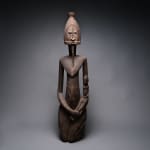Dogon Female Ancestor Sculpture, 19th Century CE - 20th Century CE
Wood
118.7 x 26 cm
46 3/4 x 10 1/4 in
46 3/4 x 10 1/4 in
PF.5788 (LSO)
Further images
This enigmatic figure is an ancestor figure from the Dogon people of Mali. The curvilinear design and the accompanying child suggest a female. However, the gender is deliberately ambiguous, and...
This enigmatic figure is an ancestor figure from the Dogon people of Mali. The curvilinear design and the accompanying child suggest a female. However, the gender is deliberately ambiguous, and it may be intended to represent a nommo – a mythological hermaphroditic ancestor. The torso is elongated and elegant, with a plate-like eminence on the thorax. The neck is columnar, supporting a tall, angular, linear head with a pointed beard. The apex of the head is crowned with a small, inverted cone. A child is cradled on the left arm.
The Dogon people of the Bandiagara escarpment, Mali, have been described as the most studied and least understood tribal group in Africa. They moved to this area in the 15th century, escaping the Mande kingdom and slavery at the hands of Islamic groups, and displaced a number of local tribes. They are excessively prolific in terms of artistic production; masks/figures in stone, iron, bronze/copper and of course wood are all known, in addition to cave/rock painting and adaptation of more modern materials. While Islam is prominent in and around the Dogon area, they have remained defiantly figurative in their artistic expression, a tradition which of course is technically banned under Islamic law.
Secular items – such as headrests, granary doors/locks and troughs – are decorated with iconographic designs that bestow benedictions upon the user or owner. There are 78 extant mask forms (and numerous extinct variants) with applications ranging from circumcision to initiation, funeral rites and the commemoration of twins, snakes, ancestors and hogons (holy men). It is not an understatement to claim that the Dogon are obsessed with their ancestors, both historical and mythical. Ancestor sculptures are partly based upon Tellem (lit. “we found them”) sculptures recovered from caves on the escarpment, and were commonly kept by the spiritual leader (hogon) away from the public eye, in family houses or sanctuaries.
This seemingly hermaphroditic figure relates to a real or fictional ancestor, including the semi-human nommo that feature at the very genesis of the Dogon people. In practical terms, it was kept in a shrine and anointed by the hogon, who would have revered it as a religious artefact. This is a remarkable and imposing piece of African art.
The Dogon people of the Bandiagara escarpment, Mali, have been described as the most studied and least understood tribal group in Africa. They moved to this area in the 15th century, escaping the Mande kingdom and slavery at the hands of Islamic groups, and displaced a number of local tribes. They are excessively prolific in terms of artistic production; masks/figures in stone, iron, bronze/copper and of course wood are all known, in addition to cave/rock painting and adaptation of more modern materials. While Islam is prominent in and around the Dogon area, they have remained defiantly figurative in their artistic expression, a tradition which of course is technically banned under Islamic law.
Secular items – such as headrests, granary doors/locks and troughs – are decorated with iconographic designs that bestow benedictions upon the user or owner. There are 78 extant mask forms (and numerous extinct variants) with applications ranging from circumcision to initiation, funeral rites and the commemoration of twins, snakes, ancestors and hogons (holy men). It is not an understatement to claim that the Dogon are obsessed with their ancestors, both historical and mythical. Ancestor sculptures are partly based upon Tellem (lit. “we found them”) sculptures recovered from caves on the escarpment, and were commonly kept by the spiritual leader (hogon) away from the public eye, in family houses or sanctuaries.
This seemingly hermaphroditic figure relates to a real or fictional ancestor, including the semi-human nommo that feature at the very genesis of the Dogon people. In practical terms, it was kept in a shrine and anointed by the hogon, who would have revered it as a religious artefact. This is a remarkable and imposing piece of African art.





